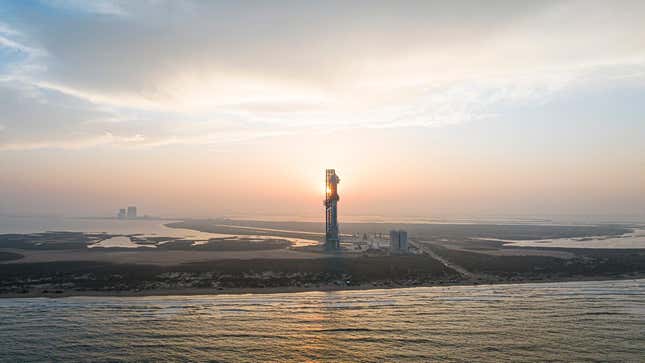
A frozen valve forced a postponement on Monday, but Elon Musk’s rocket company SpaceX is now ready for the do-over. It’s the most anticipated launch of the year, and we’ve got you covered for what will hopefully be the dramatic debut of Starship. Update on the launch: SpaceX’s Starship rocket successfully took flight but exploded minutes into the mission.
Should all go as planned, the 90-minute mission will get started at 9:28 a.m. ET on Thursday, April 20. SpaceX’s coverage. available at the live feed below, will begin around 45 minutes before the 62-minute launch window opens.
A generous number of third-party live streams are also available, including webcasts offered by NASASpaceflight, Everyday Astronaut, and Lab Padre, all of which are accessible below. These broadcasts will run throughout the course of the morning and feature informative commentaries of propellant loading and other launch preparations.
Starship consists of two reusable parts, the Super Heavy booster and the upper stage bearing the name of the megarocket. The two components are stacked together for launch, creating a rocket that stands 394 feet (120 meters) tall.
For the inaugural mission, Starship will attempt to blast off from SpaceX’s Starbase facility in Boca Chica, Texas and reach space. After stage separation, the booster will fall back down to the Gulf of Mexico, while the upper stage will attempt to achieve orbital velocity. Starship won’t complete a full orbit of Earth, as it’s expected to crash into the Pacific Ocean near Hawaii. Both stages are designed to perform vertical landings, but SpaceX is reserving those tests for future missions. A more detailed account of the mission is available here.
No customer payloads are included in this mission, which is likely wise. Failure at some stage of the rocket’s first flight is highly likely, given the experimental nature of Starship and the nascent phase of the program. “With a test such as this, success is measured by how much we can learn, which will inform and improve the probability of success in the future as SpaceX rapidly advances development of Starship,” according to the company.
Should Starship clear the launch and catch tower, it will become the most powerful rocket in the world, past or present. The Super Heavy is powered by 33 Raptor 2 engines, which are expected to produce 16.5 million pounds of thrust. By comparison, NASA’s new Space Launch System, which debuted in November 2022, produces 8.8 million pounds of thrust. SpaceX’s methane-fueled megarocket “is a fully reusable transportation system designed to carry both crew and cargo to Earth orbit, help humanity return to the Moon, and travel to Mars and beyond,” according to the company.
Should SpaceX manage to certify Starship for operational flights, the rocket will serve as a major disruptor in the spaceflight industry owing to its immense power, record-breaking payload capacity, and presumed low costs to launch. It’ll also enable unprecedented missions to space and potentially enable new types of astrophysics.
Want to know more about Elon Musk’s space venture? Check out our full coverage of SpaceX’s Starship megarocket and the SpaceX Starlink internet satellite megaconstellation. And for more spaceflight in your life, follow us on Twitter and bookmark Gizmodo’s dedicated Spaceflight page.

